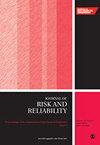A modelling approach to studying variations in newborn life support procedure
IF 1.8
4区 工程技术
Q3 ENGINEERING, INDUSTRIAL
Proceedings of the Institution of Mechanical Engineers Part O-Journal of Risk and Reliability
Pub Date : 2023-05-12
DOI:10.1177/1748006x231173595
引用次数: 1
Abstract
Variations in clinical practice are common. However, some variations may cause undesired consequences. Careful consideration of their causes and effects is necessary to assure the quality of healthcare delivery. A modelling approach that could capture these aspects would help to achieve this goal. In this paper, a Newborn Life Support procedure is modelled. This activity is considered prone to error with reduced outcomes for the patient. Hence, it is necessary to understand the nature of the activity and its variations. A Coloured Petri Net (CPN) approach and a simulation technique are used for this purpose. The CPN colours are used to represent the characteristics of babies and to control the flow of tokens representing the resuscitation procedure. Probabilistic modelling aspects include the duration of individual tasks, the choice of treatment and the condition of the baby. The model outputs consist of the percentage of babies with an unsatisfactory outcome, the percentage of babies who need full resuscitation, and the duration of the procedure until a satisfactory condition is achieved. The modelling approach is demonstrated using a number of scenarios on some common NLS variations, relating to the maximum number of ventilation and the probability of errors in the inflation procedure.研究新生儿生命维持程序变化的建模方法
临床实践中的变化是常见的。然而,一些变化可能会导致意想不到的后果。仔细考虑其原因和影响是必要的,以确保医疗保健服务的质量。能够捕获这些方面的建模方法将有助于实现这一目标。本文对新生儿生命支持过程进行了建模。这种活动被认为容易出错,降低了患者的预后。因此,有必要了解活动的性质及其变化。彩色Petri网(CPN)方法和模拟技术用于此目的。CPN的颜色用来代表婴儿的特征,并控制代表复苏程序的符号的流动。概率建模方面包括个人任务的持续时间,治疗的选择和婴儿的状况。模型输出包括结果不令人满意的婴儿的百分比,需要完全复苏的婴儿的百分比,以及达到令人满意的情况所需的手术时间。建模方法使用一些常见的NLS变化的场景进行了演示,这些变化与最大通风次数和充气过程中的错误概率有关。
本文章由计算机程序翻译,如有差异,请以英文原文为准。
求助全文
约1分钟内获得全文
求助全文
来源期刊

Proceedings of the Institution of Mechanical Engineers Part O-Journal of Risk and Reliability
ENGINEERING, MULTIDISCIPLINARY-ENGINEERING, INDUSTRIAL
CiteScore
4.50
自引率
19.00%
发文量
81
审稿时长
6-12 weeks
期刊介绍:
The Journal of Risk and Reliability is for researchers and practitioners who are involved in the field of risk analysis and reliability engineering. The remit of the Journal covers concepts, theories, principles, approaches, methods and models for the proper understanding, assessment, characterisation and management of the risk and reliability of engineering systems. The journal welcomes papers which are based on mathematical and probabilistic analysis, simulation and/or optimisation, as well as works highlighting conceptual and managerial issues. Papers that provide perspectives on current practices and methods, and how to improve these, are also welcome
 求助内容:
求助内容: 应助结果提醒方式:
应助结果提醒方式:


